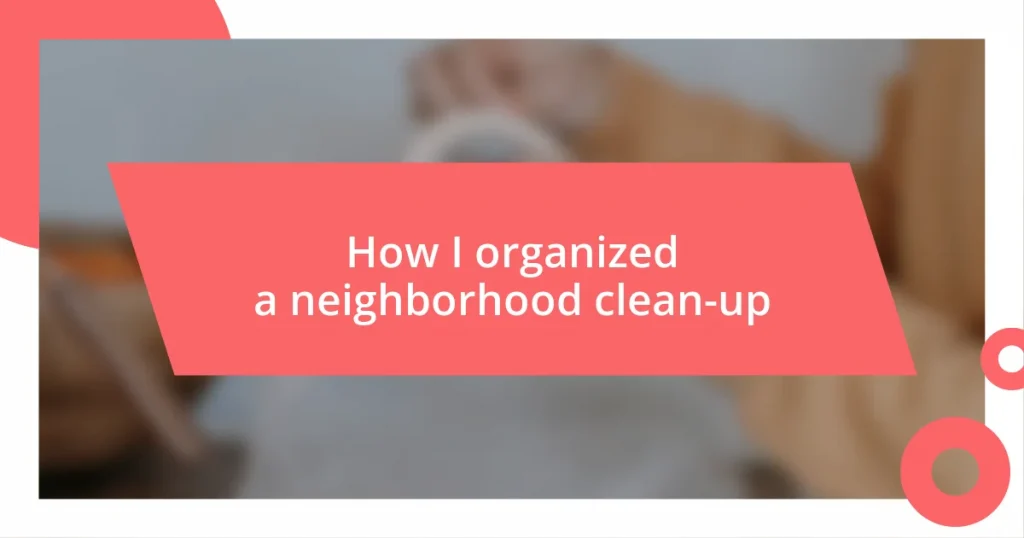Key takeaways:
- Community clean-ups foster pride, connection, and environmental protection, motivating collective action.
- Effective organization involves clear communication, strategic location choices, and gathering necessary supplies to ensure volunteer participation.
- Celebrating successes and ongoing efforts helps maintain momentum, inspiring further community initiatives for a cleaner neighborhood.
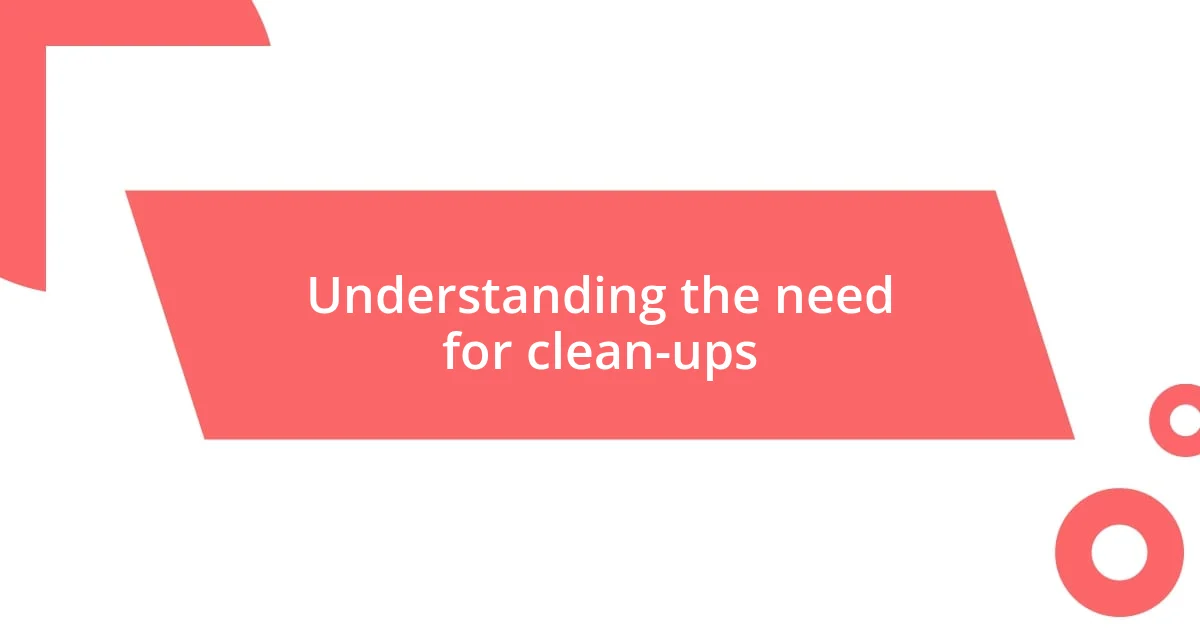
Understanding the need for clean-ups
When I moved into my neighborhood, I was struck by how litter seemed to accumulate in every corner. Seeing trash scattered in a place I wanted to call home sparked a deep need within me to take action. Isn’t it disheartening to witness our beautiful surroundings tarnished by negligence?
Beyond aesthetics, clean-ups serve a more profound purpose—they foster community pride and connection. I still remember the moment we picked up the first piece of trash together as neighbors; it felt like the ice was breaking. Can you imagine the bonding that occurs when a group unites for a common cause?
Moreover, clean-ups play a crucial role in protecting local wildlife and the environment. I often think about the animals that live nearby, who unknowingly encounter hazards due to our litter. Reflecting on these thoughts can motivate us to take those first steps; after all, what legacy do we want to leave for future generations?
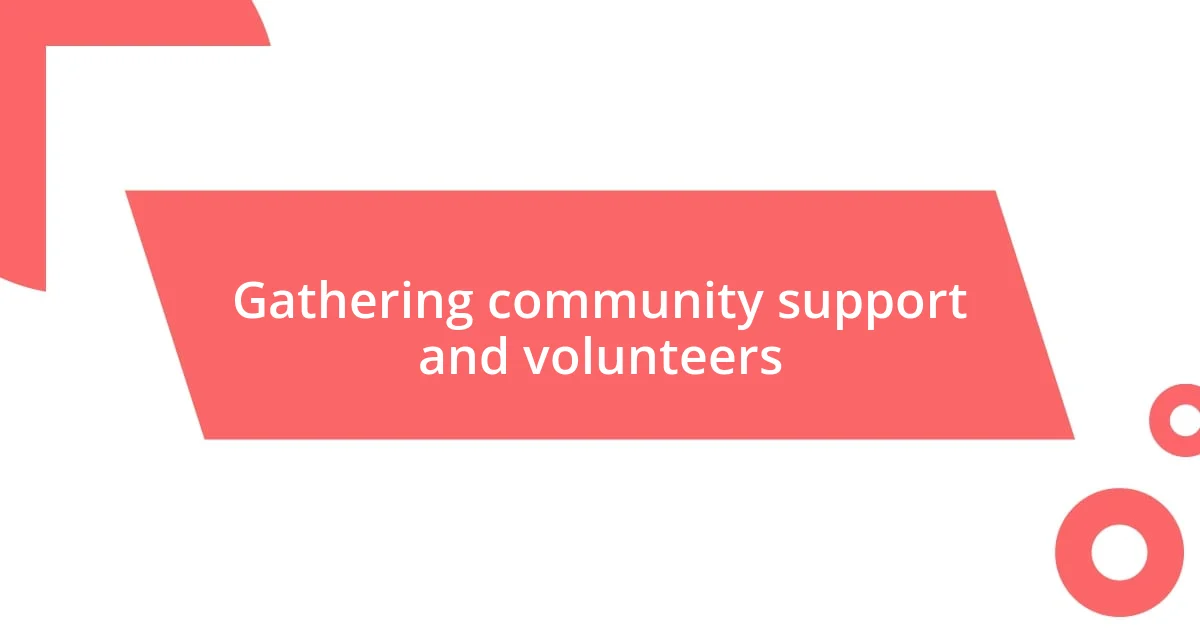
Gathering community support and volunteers
To gather community support and volunteers, I found that communication is key. Sharing my concerns and aspirations with my neighbors generated excitement. Everyone seemed eager to get involved once I expressed how our collaboration could make a tangible difference. I specifically reached out to local community boards and social media groups. There’s something empowering about seeing our collective enthusiasm grow.
Here are some effective strategies I used to rally support:
- Door-to-Door Chats: I knocked on doors, sharing my vision and inviting people to join. This personal touch often sparked interest.
- Social Media Posts: I created an event on local platforms where neighbors could sign up and share ideas, making it easier for them to get involved.
- Collaborating with Local Businesses: I asked local shops to sponsor supplies and promote the event, which fostered a sense of partnership.
- Community Flyers: I designed and distributed flyers to inform and excite residents about the upcoming clean-up day.
Engaging the community wasn’t just about logistics; it was about building relationships. Seeing familiar faces expressing their willingness to lend a hand brought a sense of warmth that fueled my commitment, turning a simple clean-up into a gathering of friends who shared a love for our environment.
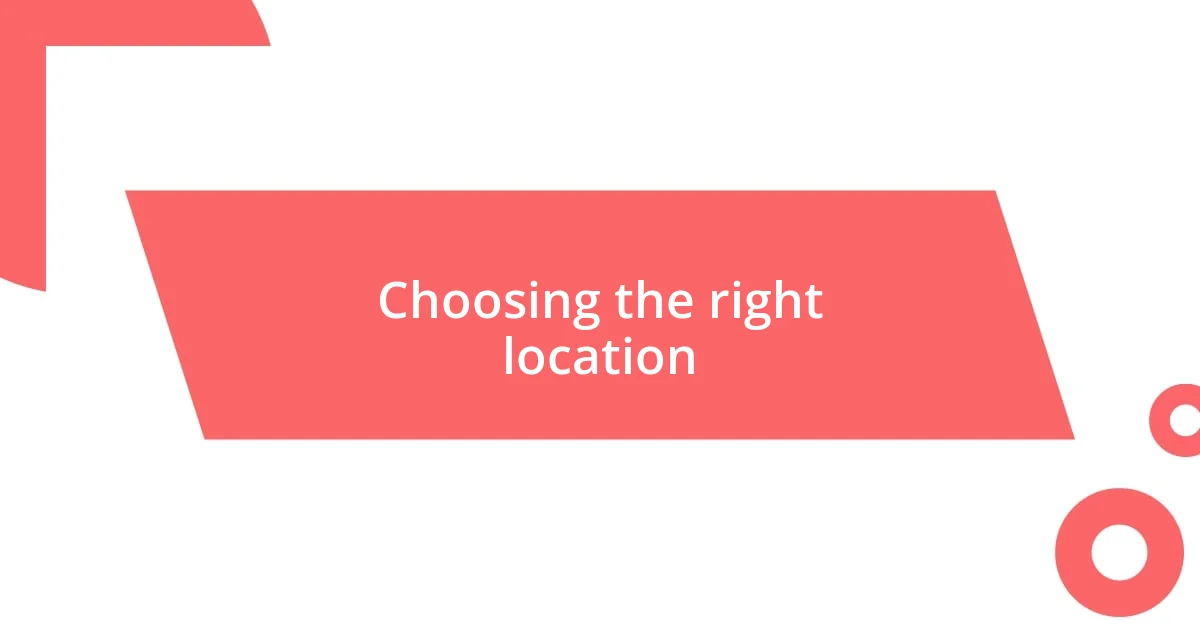
Choosing the right location
When it comes to choosing the right location for your neighborhood clean-up, the decision can significantly impact both participation and effectiveness. Personally, I found that focusing on areas frequently used by residents—like parks, schools, or community centers—encouraged greater involvement. After all, it’s one thing to clean an empty lot, but seeing familiar faces in an everyday space fosters a sense of shared ownership and commitment.
Another key aspect to consider is the type of litter present in potential locations. In my experience, targeting spots that tend to accumulate trash regularly, such as bus stops or picnic areas, can yield immediate results. A local park I chose had a play area surrounded by debris; once we tackled it, the transformation was breathtaking. Witnessing children enjoy that rejuvenated space was incredibly rewarding and reinforced the value of our efforts.
Lastly, accessibility plays a crucial role. I learned the hard way that selecting a location that’s easy to reach and navigate encourages more people to join in. For example, I opted for a park that had ample parking and public transportation nearby, which contributed to a larger turnout. A clean-up should feel like a celebration, not a chore, and making it accessible is key to building excitement.
| Criteria | Considerations |
|---|---|
| Location Type | High traffic areas encourage participation. |
| Type of Litter | Select areas with frequent litter issues for immediate impact. |
| Accessibility | Ensure easy access to encourage more volunteers. |
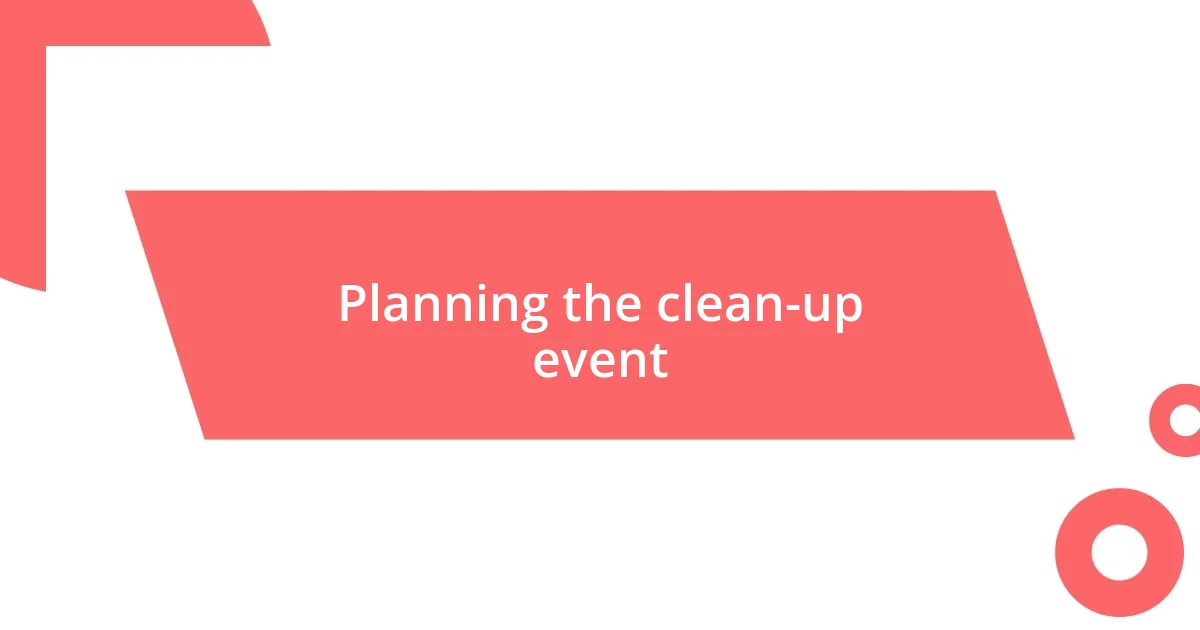
Planning the clean-up event
Planning a clean-up event requires careful thought and strategy. I realized early on that setting a specific date and time was crucial; if people don’t know when to show up, they can’t participate. I chose a weekend morning when families were likely to be free, hoping to make it a fun community outing rather than just a chore.
I also learned the importance of setting a clear agenda for the day. One of my favorite moments was when I mapped out different tasks, like litter collection, landscaping, and organizing recycling, and shared that with volunteers ahead of time. This not only made everyone feel included but also sparked excitement. Who doesn’t want to know how their efforts contribute to a more beautiful neighborhood?
Finally, I discovered that providing incentives can really boost enthusiasm. I reached out to a local cafe, which surprised me by offering free coffee and pastries for all participants. This small gesture transformed our clean-up into a social event, turning what could have been a mundane task into a delightful gathering of neighbors, all motivated to improve our shared space while enjoying some treats. Isn’t it incredible how a little planning can create such a profound sense of community?
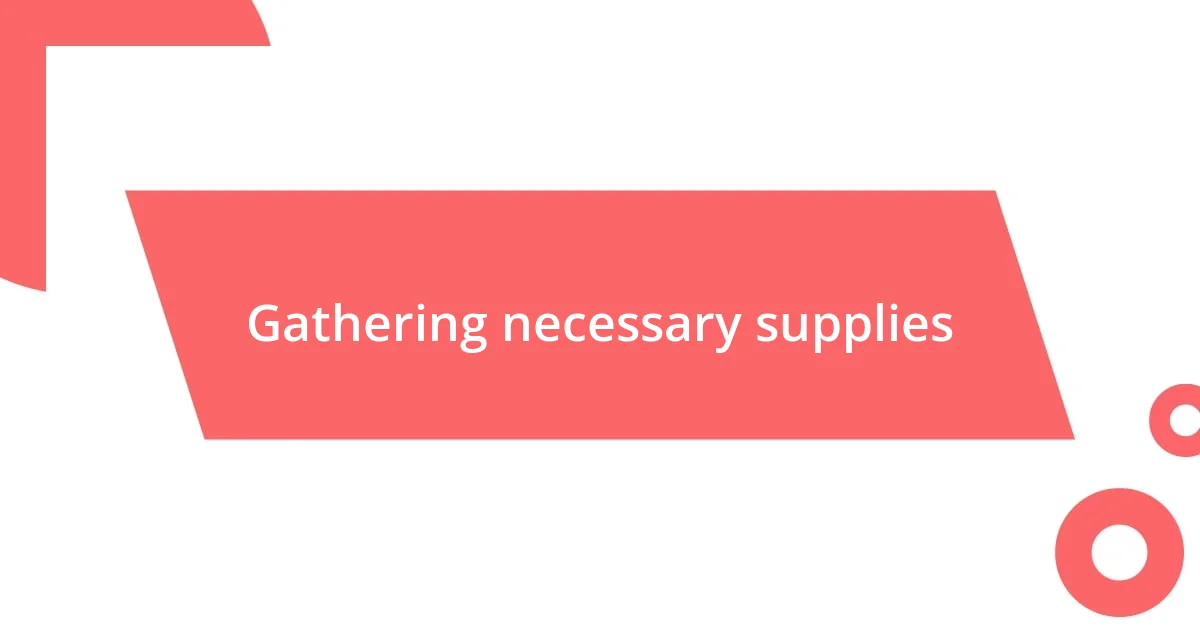
Gathering necessary supplies
One of the first steps I took for our neighborhood clean-up was to gather the necessary supplies. I quickly realized that having the right tools could make a big difference. For instance, I opted for sturdy trash bags, gloves, and even some grabbers to make picking up litter easier. It felt good to be prepared, knowing that everyone would have what they needed to contribute without hesitation.
I also thought about the energy and motivation we’d need, so I included plenty of water and snacks. On the day of our clean-up, as we munched on granola bars and sipped ice-cold water, I saw how small gestures like these really lifted everyone’s spirits. Everyone was eager to dive in, and I could sense that the snacks were doing more than just fueling our bodies; they were bringing us together as a community.
Next, I reached out to local businesses for additional support. It was a bit nerve-wracking, but when I received donations of extra gloves and even some first-aid kits, I felt an overwhelming sense of gratitude. Those contributions were more than just items—they were a testament to our community rallying together. Don’t you think that when the community collaborates, it sparks a sense of belonging that makes the event even more meaningful? Seeing that unity reminded me that we’re all in this together, striving for a cleaner, more vibrant neighborhood.
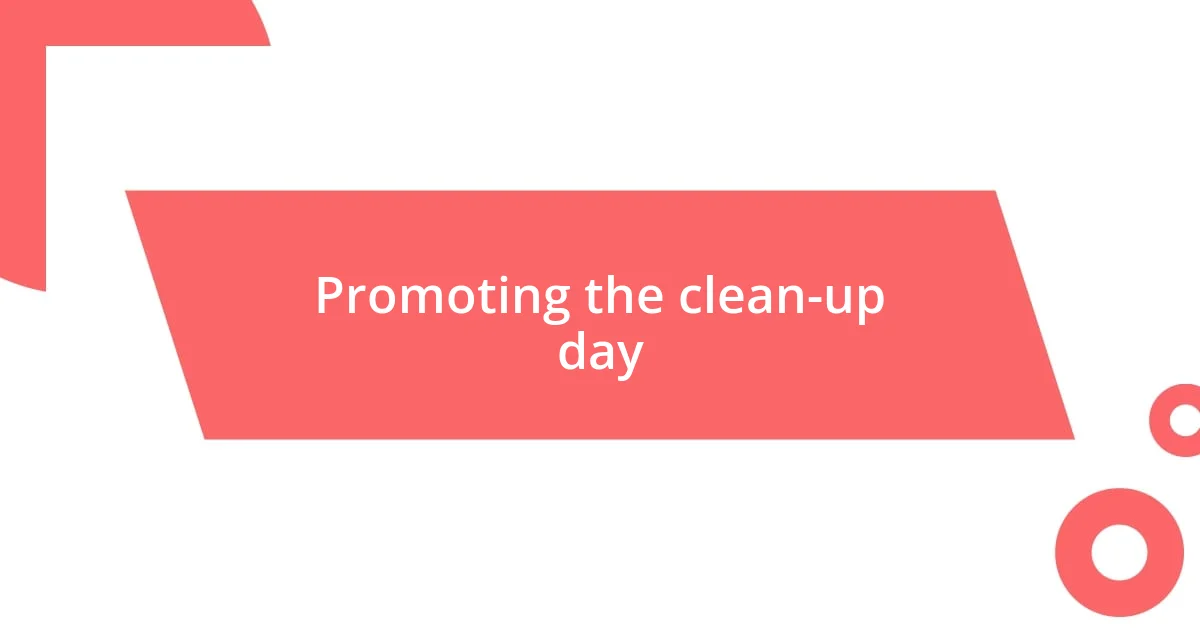
Promoting the clean-up day
To effectively promote our clean-up day, I tapped into the power of social media. I crafted an engaging post that included vibrant photos from previous clean-ups, making it visually appealing and relatable. You know, I really felt a sense of excitement when I noticed likes and shares accumulating. It was a clear reminder that when you share your passion, others are often eager to jump on board.
I also took the time to create flyers and distribute them in common areas. It was a simple yet effective way to reach folks who may not be online. I vividly remember chatting with a neighbor at the local park who, after seeing the flyer, expressed how happy he was to be involved. It felt great knowing that just a piece of paper could spark genuine interest in helping our neighborhood bloom.
In addition, word-of-mouth proved invaluable. I encouraged friends and family to invite their neighbors, creating a ripple effect in our community. I was pleasantly surprised when a neighbor I had never spoken to showed up on the day, her eyes bright with enthusiasm. Isn’t it fascinating how a small conversation can lead to unexpected connections? Building a sense of community often starts with simply extending an invitation.
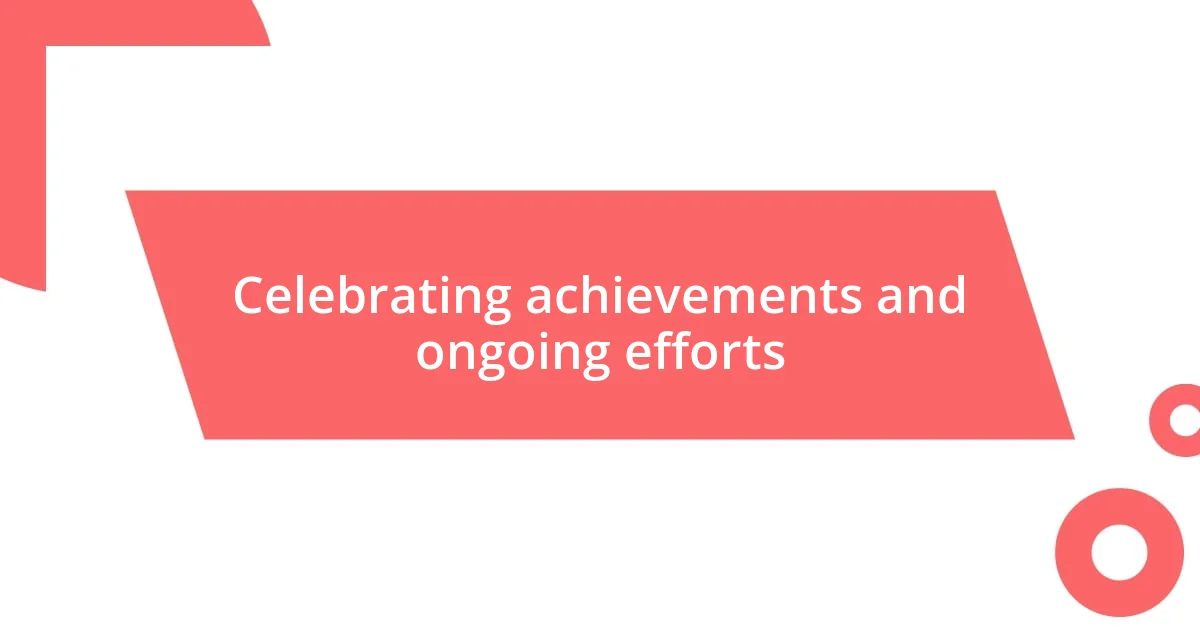
Celebrating achievements and ongoing efforts
The day after our clean-up, I felt a tangible buzz in the air. As I walked through the neighborhood, I was greeted by the sight of clean sidewalks and vibrant gardens—the outcomes of our collective effort. It was so fulfilling to see how a few hours of hard work transformed not only our environment but also our community spirit. Have you ever experienced that thrilling moment when all your hard work really pays off? It’s a joy that’s hard to put into words.
What truly amazed me was how our clean-up day became a catalyst for ongoing efforts. Several neighbors, inspired by the success, started organizing regular clean-up weekends. I remember receiving a message from a friend who proposed a monthly clean-up club, and I couldn’t help but feel proud. It’s incredible how one action can ripple out, inspiring others to take initiative and build a cleaner neighborhood. It’s moments like these that remind me how interconnected we truly are.
As we move forward, I think it’s essential to celebrate not just the big events but also the small victories. Every bit of litter picked up is a testament to our commitment to our community. I often reflect on conversations I’ve had with neighbors who noticed our efforts and felt compelled to pitch in. It’s heartening to realize that our achievements, no matter how small, fuel ongoing efforts. Don’t you think each positive action, whether it’s a shared smile or a clean street, contributes to a brighter, more cohesive community?










